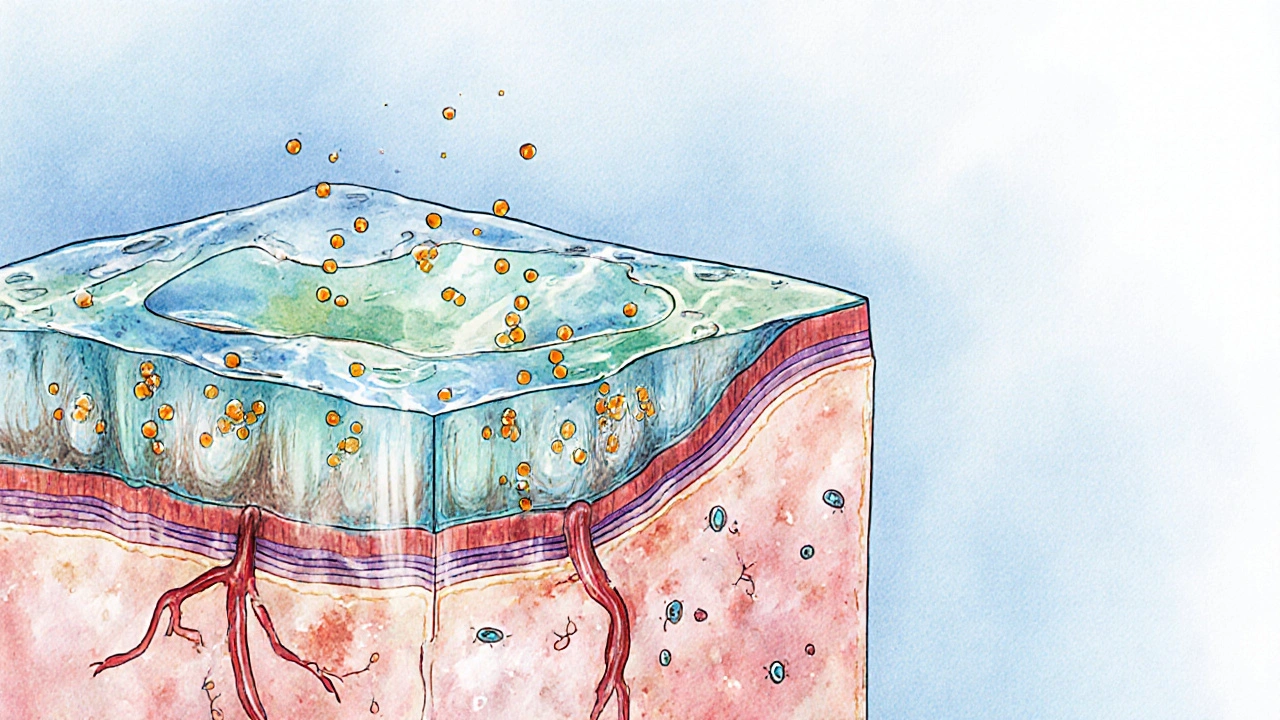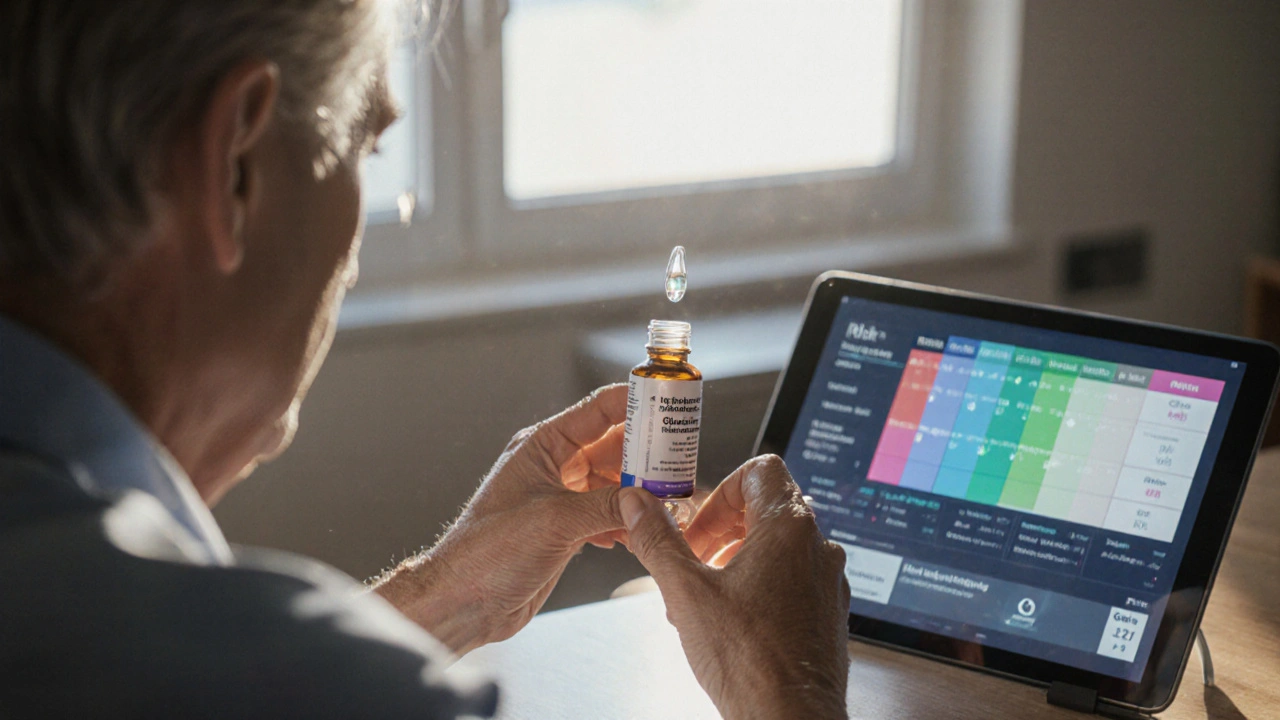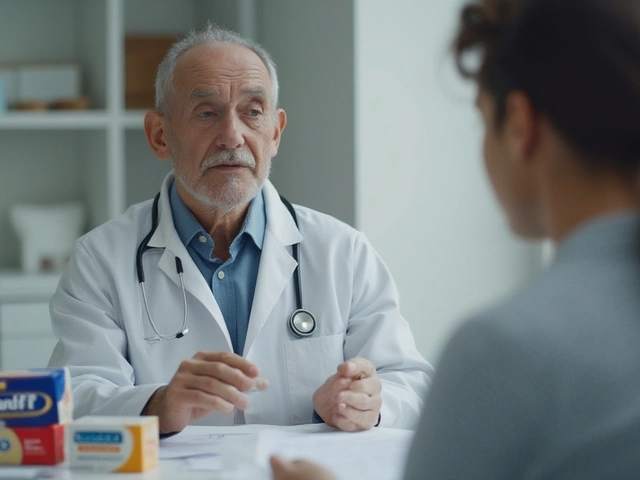Glaucoma & Dry Eye Risk Calculator
Enter your details and click "Calculate Risk Level" to see your assessment.
Quick Take
- Open-angle glaucoma often requires eye drops that can irritate the ocular surface.
- Preservatives like benzalkonium chloride reduce tear film stability, raising dry‑eye risk.
- Both conditions share age‑related changes and inflammation as common risk factors.
- Choosing preservative‑free glaucoma meds or adding lubricants can keep both eyes healthy.
- Regular eye‑care monitoring helps catch dry‑eye symptoms early in glaucoma patients.
Ever wondered why some people with glaucoma keep complaining about gritty eyes or burning sensations? The link isn’t a coincidence. Below we break down how open-angle glaucoma and dry eye syndrome intersect, what the science says, and practical steps to manage both at once.
Understanding Open-Angle Glaucoma
When discussing eye health, Open‑Angle Glaucoma is a chronic optic neuropathy marked by progressive loss of retinal ganglion cells, usually driven by elevated intraocular pressure (IOP). The disease progresses silently; many patients only notice it after peripheral vision loss.
The key anatomical player is the Trabecular Meshwork, a spongy tissue that drains aqueous humor from the anterior chamber. In open‑angle glaucoma, this meshwork becomes less efficient, causing IOP to rise.
Typical treatment starts with topical eye drops that lower IOP. Prostaglandin analogs, beta‑blockers, carbonic anhydrase inhibitors, and alpha agonists are the most common classes.
What Is Dry Eye Syndrome?
Dry Eye Syndrome is a multifactorial disease of the ocular surface that results in tear film instability, increased osmolarity, and inflammation. Symptoms range from mild discomfort to severe burning, blurred vision, and susceptibility to infection.
The tear film consists of three layers: a lipid outer layer, an aqueous middle layer, and a mucin inner layer. Disruption of any layer can trigger dry‑eye symptoms, and the condition is often labeled as an ocular surface disease.
Risk factors include aging, hormonal changes, environmental stress (wind, low humidity), and certain medications-including many used for glaucoma.
How Glaucoma Treatments Influence the Tear Film
Most glaucoma eye drops contain a preservative, most often Benzalkonium Chloride (BAK), to keep the bottle sterile. While BAK is effective, repeated exposure can damage epithelial cells, reduce goblet‑cell density, and destabilize the lipid layer of the tear film.
Prostaglandin analogs, such as latanoprost, are widely prescribed for their once‑daily dosing and strong IOP‑lowering effect. However, studies show they can increase conjunctival inflammation, which worsens dry‑eye sensations.
Beta‑blockers (e.g., timolol) and carbonic anhydrase inhibitors (e.g., dorzolamide) also carry a dry‑eye risk, especially when combined with BAK. The cumulative effect is a higher chance of ocular surface disease in glaucoma patients.
| Medication Class | Common Agent | Preservative Used | Typical Dry‑Eye Side‑Effect |
|---|---|---|---|
| Prostaglandin Analogs | Latanoprost | BAK (or preservative‑free) | Conjunctival hyperemia, reduced tear break‑up time |
| Beta‑Blockers | Timolol | BAK | Decreased tear production, ocular irritation |
| Carbonic Anhydrase Inhibitors | Dorzolamide | BAK | Surface inflammation, stinging |
| Alpha Agonists | Brimonidine | BAK | Mild dryness, allergic‑type reaction |
| Rho‑kinase Inhibitors | Netarsudil | Preservative‑free options | Generally lower dry‑eye risk |

Shared Risk Factors and Overlap
Age is a major common denominator. Both open‑angle glaucoma and dry‑eye syndrome become more prevalent after the sixth decade because the trabecular meshwork stiffens and tear production naturally declines.
Inflammation also bridges the two. Chronic low‑grade inflammation in glaucoma can spread to the ocular surface, while dry‑eye‑induced inflammation can increase oxidative stress on the optic nerve.
Systemic conditions such as diabetes and autoimmune diseases (e.g., Sjögren’s syndrome) further blur the line, as they predispose patients to both elevated IOP and tear‑film dysfunction.
Clinical Evidence of the Relationship
Multiple cross‑sectional studies published between 2018‑2024 report that up to 40% of glaucoma patients experience clinically significant dry‑eye symptoms, compared with 15‑20% in age‑matched controls. One 2022 multi‑center trial measured tear‑film break‑up time (TBUT) in 300 patients on prostaglandin analogs; the average TBUT dropped from 9seconds to 6seconds after six months of therapy.
Another longitudinal study tracked newly diagnosed glaucoma patients over two years. Those switched to preservative‑free formulations showed a 30% improvement in ocular surface disease index (OSDI) scores, indicating that the preservative itself plays a sizable role.
These findings reinforce a clear, bidirectional link: glaucoma treatment can trigger or aggravate dry eye, and existing dry‑eye disease may affect medication tolerance and adherence.
Managing Both Conditions Together
1. Ask for preservative‑free drops. Many pharmacies now stock BAK‑free versions of prostaglandin analogs and beta‑blockers. They’re often marketed as PF‑formulations.
2. Use lubricating eye drops-prefer preservative‑free artificial tears-several times a day, especially before and after glaucoma medication.
3. Consider adjunctive oral omega‑3 supplements; they have been shown to improve meibomian gland function and reduce inflammatory markers on the ocular surface.
4. Schedule regular ocular surface assessments during glaucoma follow‑ups. Measuring TBUT, Schirmer’s test, and OSDI can catch early dry‑eye changes.
5. In severe cases, a punctal plug may be inserted to retain tears longer, but only after confirming the underlying glaucoma is well‑controlled.
6. Educate patients about proper drop technique: a small drop, gentle eyelid closure, and a brief pause before applying lubricants can minimize wash‑out and reduce surface irritation.
Key Takeaways for Patients and Clinicians
- Open‑angle glaucoma treatment frequently involves topical drugs that can irritate the eye surface.
- Preservatives, especially benzalkonium chloride, are the main culprits behind medication‑induced dry eye.
- Age‑related changes, inflammation, and systemic diseases create a shared risk environment.
- Switching to preservative‑free formulations and adding lubricants can dramatically improve comfort.
- Regular monitoring of both IOP and ocular surface health ensures optimal outcomes for vision preservation.
Frequently Asked Questions
Can glaucoma medication cause permanent damage to the tear film?
Most of the damage is reversible. Stopping or switching from preservative‑containing drops, combined with lubricants, often restores tear‑film stability within weeks. However, chronic inflammation can lead to lasting goblet‑cell loss if left unchecked.
Are there any glaucoma drugs that don’t affect the eyes’ moisture?
Rho‑kinase inhibitors such as netarsudil are often formulated preservative‑free and have a lower dry‑eye profile. Still, individual tolerance varies, so a trial period is advisable.
Should I stop my glaucoma drops if my eyes feel dry?
Never stop medication without consulting your eye‑care professional. Instead, discuss preservative‑free alternatives or adjunct lubricants. Abrupt discontinuation can spike IOP and risk vision loss.
How often should I have my eyes examined if I have both conditions?
At minimum, every six months for IOP checks and visual field testing, plus an ocular surface exam. If dry‑eye symptoms flare, a short‑interval visit (e.g., every 2‑3 months) may be needed.
Do lifestyle changes help with both glaucoma and dry eye?
Yes. Maintaining a healthy weight, staying hydrated, using a humidifier in dry environments, and avoiding smoking can lower IOP and support tear‑film health. Regular exercise also improves ocular blood flow.






Ajay Kumar
Hey folks, great rundown on how glaucoma meds can dry out your eyes. I personally switched to preservative‑free latanoprost after noticing that gritty feeling, and it made a noticeable difference. It’s amazing how something as small as a drop bottle can impact comfort. If you’re on beta‑blockers, consider a combo with artificial tears before bedtime. Also, keep your eyelids clean – a gentle wash can help the ocular surface recover. Stay proactive and keep an eye on those symptoms!
Richa Ajrekar
Honestly this article could have been shorter. The grammar is fine but the content seems to repeat common knowledge.
Pramod Hingmang
Glaucoma meds are a double‑edged sword they lower pressure yet can dry the eye surface. Switching to preservative‑free options is like giving your eyes a breather. Remember to blink often especially after instilling drops. A splash of preservative‑free artificial tears can calm irritation. Keep the routine simple and your eyes will thank you.
Benjamin Hamel
While I appreciate the practical tips, I think the piece overlooks the fact that not all patients experience dry eye from BAK‑containing drops. Some studies suggest that the incidence varies widely based on individual tear film resilience, and that lifestyle factors such as screen time can be just as culpable. Moreover, the article could have delved deeper into newer drug delivery systems like gel‑forming drops, which aim to reduce exposure frequency. It also glosses over the cost barrier many face when opting for preservative‑free formulations; the price differential can be substantial. In addition, the emphasis on omega‑3 supplements, although evidence‑based, might distract from more immediate interventions like adjusting the drop technique. That said, the overall message about monitoring ocular surface health remains valid, but a more nuanced discussion would serve readers better.
Christian James Wood
Let me be blunt – most patients don’t even realize they’re sabotaging their own vision by neglecting the dry‑eye side effects of their glaucoma regimen. First, the preservatives, especially benzalkonium chloride, are toxic to epithelial cells and goblet cells, leading to a cascade of inflammation that the average eye‑doctor might dismiss as “minor irritation.” Second, the chronic inflammation doesn’t just stay on the surface; it can exacerbate optic nerve stress, potentially accelerating glaucoma progression. Third, we see a pattern where patients, frustrated by the burning sensation, skip doses, causing spikes in intraocular pressure that could have been avoided with proper ocular surface management. Fourth, the literature is clear: preservative‑free formulations dramatically reduce ocular surface disease index scores, yet many clinicians continue prescribing the cheaper, preservative‑laden options. Fifth, the convenience of once‑daily dosing often masks the cumulative toxic load on the tear film. Sixth, the use of artificial tears is not a mere adjunct; it should be a core component of the treatment plan, applied before and after the glaucoma drops to create a protective barrier. Seventh, patient education is severely lacking – most patients aren’t warned about the potential for dry eye until they already suffer from it. Eighth, the role of meibomian gland dysfunction in this population is under‑researched, despite its contribution to evaporative dry eye. Ninth, the impact of systemic factors like diabetes and autoimmune disease compounds the problem, demanding a holistic approach. Tenth, switching to preservative‑free options, while sometimes more expensive, can be cost‑effective in the long run by reducing the need for additional anti‑inflammatory medications. Eleventh, clinicians should routinely assess tear breakup time and Schirmer’s test during glaucoma follow‑ups, not just focus on IOP. Twelfth, newer drug delivery platforms, such as punctal plugs delivering sustained‑release medication, offer promising avenues to minimize surface exposure. Thirteenth, lifestyle modifications – humidifiers, hydration, limiting screen time – are simple yet powerful tools that are often omitted from patient instructions. Fourteenth, the psychological burden of persistent eye discomfort can affect compliance, so addressing dry eye is as much about quality of life as it is about ocular health. Fifteenth, in my practice, patients who receive a comprehensive ocular surface management plan alongside their glaucoma therapy report significantly higher satisfaction scores. In short, ignoring dry eye in glaucoma patients is not just an oversight; it’s a systemic failure that jeopardizes both comfort and vision.
Rebecca Ebstein
Wow, that was intense! I totally get the vibe – switching to preservative‑free drops really helped me. Also, using a good artificial tear before bedtime has made my eyes feel so much better. Keep it up, you got this!
Artie Alex
From a pharmacovigilance standpoint, the adverse ocular surface events linked to benzalkonium chloride are well‑documented. The cytotoxicity profile indicates a dose‑dependent disruption of corneal epithelial tight junctions, which precipitates increased osmolarity and subsequent inflammatory cascades. Clinicians should therefore incorporate a risk‑benefit analysis when prescribing chronic topical therapy, especially in patients with pre‑existing meibomian gland dysfunction. Furthermore, the adoption of preservative‑free delivery systems aligns with the principles of precision medicine, mitigating iatrogenic sequelae while preserving therapeutic efficacy.
abigail loterina
Great points! In plain words, if you can get drops without the nasty chemicals, do it. Adding a simple lubricating drop can keep your eyes comfy. It’s easy and makes a big difference.
Roger Cole
Short and sweet – check your drops, use preservative‑free if possible.
Krishna Garimella
Eyes are like gardens; they need the right balance of water and care. When glaucoma meds dry them out, it’s like pulling the plug on a thirsty plant. Switching to preservative‑free formulas is like giving your garden a gentle rain instead of a harsh spray. Pair that with a good artificial tear, and you’re essentially watering the roots while protecting the leaves. Stay vigilant, and don’t let the dryness win – your vision deserves the best.
nalina Rajkumar
Totally feel you 🙌 keep those drops and tears balanced 🌊👀
Michael Barrett
One could argue-perhaps- that the inherent complexity of ocular pharmacodynamics necessitates a multidimensional approach; however; in practice the over‑emphasis on theoretical constructs often obfuscates straightforward clinical recommendations. The literature-though extensive-still lacks a consensus on the optimal frequency of preservative‑free switch, leading to varied practitioner behaviors. Nonetheless; we must strive for pragmatism.
Inma Sims
Ah, the age‑old paradox of over‑analysis. While the academic debate is... fascinating, patients simply need clear guidance: avoid BAK if you can, use tears, and keep your eyes happy. Cheers.
Gavin Potenza
Alright, I get the scientific spiel, but at the end of the day, it’s about what works for you. If you’re comfortable with a preservative‑free drop, go for it. If not, just keep an eye on any irritation and talk to your doc. No need to overcomplicate.
Virat Mishra
Honestly the article is just re‑hashing what every eye doc already knows. People should read the label, not a blog.
Daisy Aguirre
Hey team! 🌟 If you’re juggling glaucoma meds and dry‑eye drama, remember you have options. Preservative‑free drops are a game‑changer, and a splash of lubricant before bed can feel like a spa day for your eyes. Don’t let the discomfort dictate your routine – take charge, ask your ophthalmologist about alternatives, and keep those peepers happy. You’ve got this!
Natalie Kelly
Totally agree, keep it simple and speak up about side effects.
Tiffany Clarke
Switch to preservative‑free drops.
Sandy Gold
While brevity has its merits, the nuance of ocular surface management warrants a more elaborate discourse; nonetheless, the core suggestion remains sound.